Coatlicue: The Devouring Mother. Coatlicue is a duality, like many Aztec Gods. She is the Earth Goddess as both its creator and destroyer. Coatlicue is the Mother of All, both Gods and mortals. She also devours them all. Coatlicue is the patron of dead mothers who passed away from childbirth. Coatlicue’s name is pronounced “koh-at-lee-kway” and translates as “serpent skirt.” She’s into snakes.
December, 2022. Welcome to the Aztec God of the Month Club! This is the first installment of our curated collection of twelve wild ones from the storied Aztec pantheon. The Club and its many perks are fully explained in the introduction article entitle: “Sign Up for the Aztec-God-of-the-Month Club.” This article, available exclusively on this website, gives our readers a peek preview of all our twelve sizzlin’ Aztec Gods.
Coatlicue: Embrace Her at the Beginning, Flee from her at the End. Run Fast
Today, we present our first Club installment. This article rolls out the highlights, and the lowlights, of Coatlicue, the Earth Mother Goddess. She is one of those Gods who has a dual nature, as do many other Aztec Gods. It is easy to categorize such duality as black and white; or “good” versus “evil”, — but no. The seeming opposites embedded here reflect the seamless transitions in the human and Divine experiences. As such, Coatlicue is the Earth Mother Goddess who both nurtures and devours her children, including us all. She will gently guide you from the womb and later, with fierce monstrosity, pummel you into your tomb. She is there at the beginning and the conclusion, the world without end.
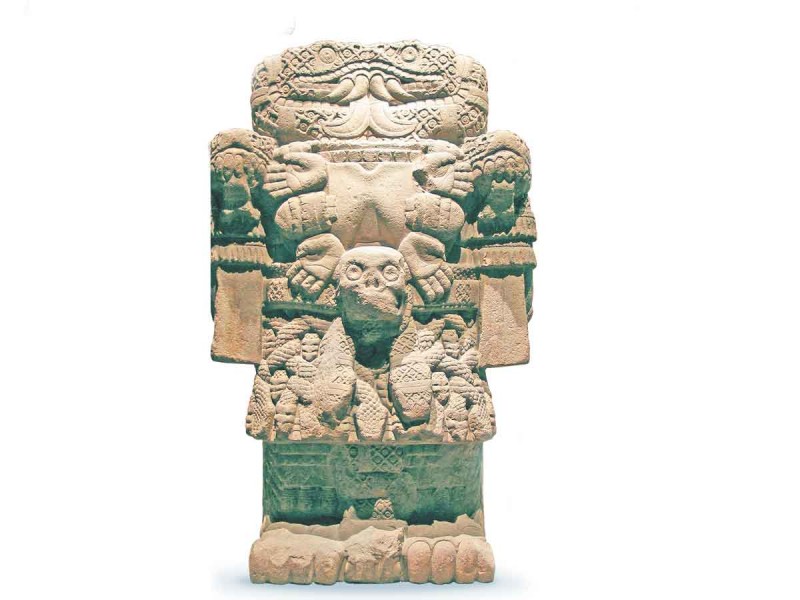
Left: The most popular, standard image of Coatlicue. This version has this great color pattern, and not the usual boring rock gray. Even so, this Coatlicue carving is so busy that it is hard to discern the individual elements. And how do these elements fit together to explain an Earth Mother who is both child nurturer and earth destroyer? As seen below, this statue of Coatlicue is dissected to explain the art and symbols.
In this most famous statue of Coatlicue, she wears a skirt of writhing snakes and a necklace made of human hearts, hands, and skulls. Her feet and hands are adorned with claws and her breasts are depicted as hanging flaccid from pregnancy. Coatlicue does not present a human face.. She was beheaded during the creation of the world. The blood spurting forth from her neck formed two huge serpents. These two serpents framed her face and became her visage that others beheld.
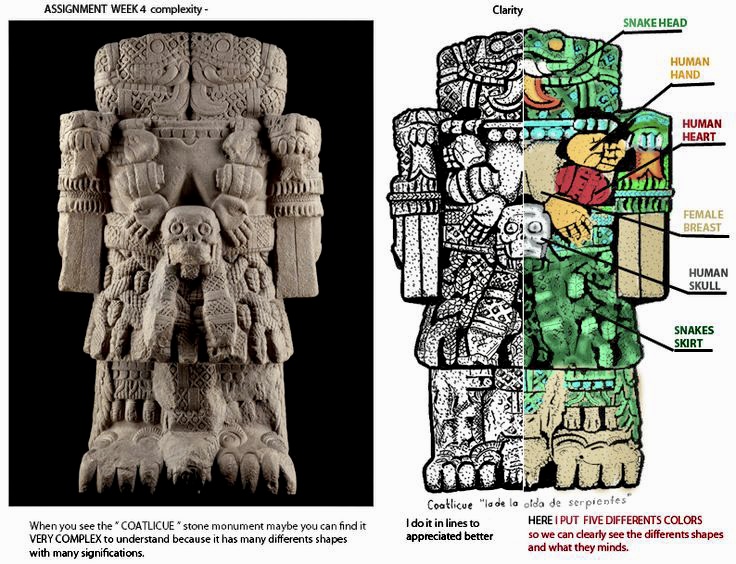
According to Aztec legend, Coatlicue was once magically impregnated by a ball of feathers that fell on her while she swept the floor of a temple. Suddenly, she became pregnant and was carrying, the fierce War God Huitzilopochtli — (pronounced “wheat-zil-oh-poach-lee”.) When this news got bandied about, Coatlicue’s daughter, Coyolxauhqui, (opronounced “coy-al-shauw-kee“) was horrified at her mother’s promiscuity. The daughter then rallied Coatlicue’s four hundred other children calling for revenge. These huge brood is collectively called the Southern Four Hundred. Coyolxauhqui goaded the enraged Four Hundred into attacking their mother and they tried to decapitate her. Coatlicue spurted two gushers of blood from her neck that became huge serpents which frame and hide her face. At the moment of the attack, Huitzilopochtli, burst from Coatlicue’s womb. He emerged as a full adult, armed with a turquoise snake and full armour, ready to avenge his mother.
In the ensuing battles, Huitzilopochtl killed many of his siblings, including his sister Coyolxauhqui. Using the turquoise snake as a weapon, Huitzilopochtl first managed to wound Coyolxauhqui. He then cut off her head. In a fit of anger, he threw Coyolxauhqui‘s head into the sky where it became the moon. Huitzilopochtl also killed many of Southern Four Hundred and threw them into the sky, also. The corpses of the Southern Four Hundred became the stars in the southern firmament. Other versions of this story have the surviving members of the Southern Four Hundred fleeing Huitzilopochtl. They can only escape his wrath by going to the end of the universe and becoming stars in the sky.
Most Aztec artistic representations of Coatlicue emphasize her deadly side, because Earth, as well as being a loving mother, is also the insatiable monster that consumes everything that lives. Thus, Coatlicue guides you out from the womb and later, drags you into the grave.
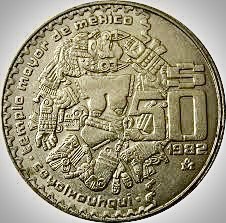
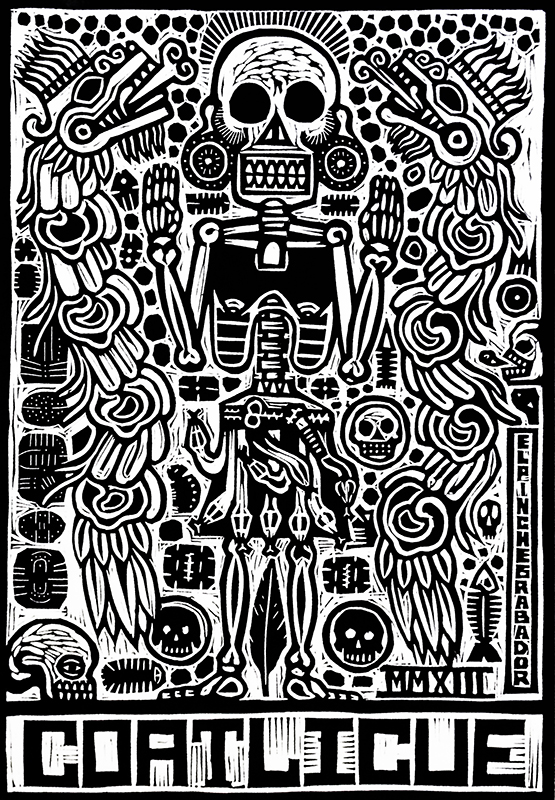
Coatlicue is Not Just Some Horrible Fairy Tale to Scare Kids
Okay, the Coatlicue below (left side) is from some scary horror story by H. P. Lovecraft. But, every different picture tells a different story. The symbolism of Coatlicue is universal; the reality is differential, depending on perspective. To muddy things even more: Psychologists could frame these Coatlicue images as examples of “the collective unconscious” seeping out from hidden recesses of mind. Coatlicue can be dismissed as having a “psychogenic overlay.” The rest of us, who are not psychologists, will know of Coatlicue in our own way. You may not know her by name, or her form may reflects your reality. Yet, Coatlicue is part of our sweet dreams, or perhaps our most fantasmic nightmares. Your pick.
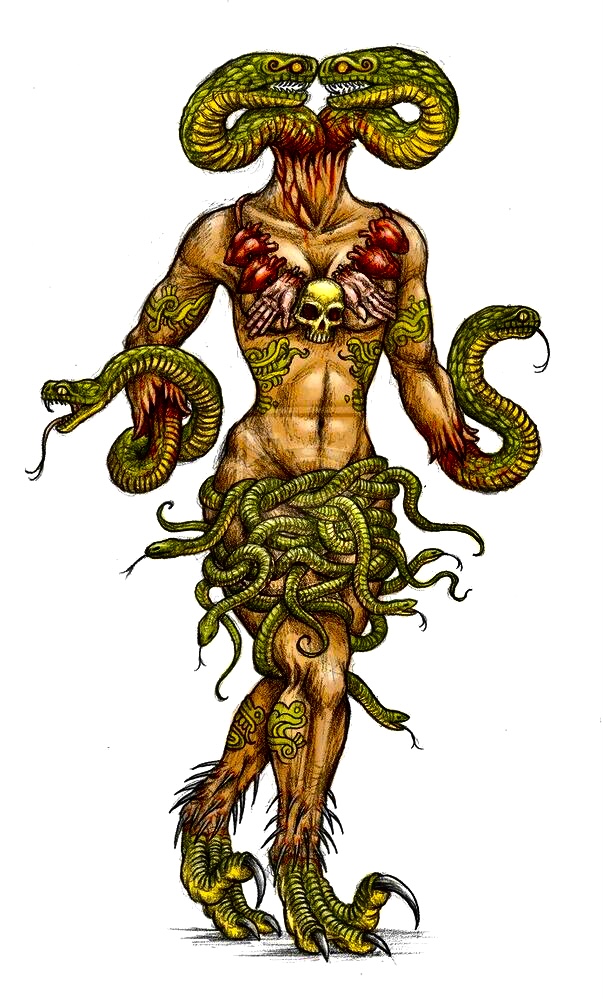
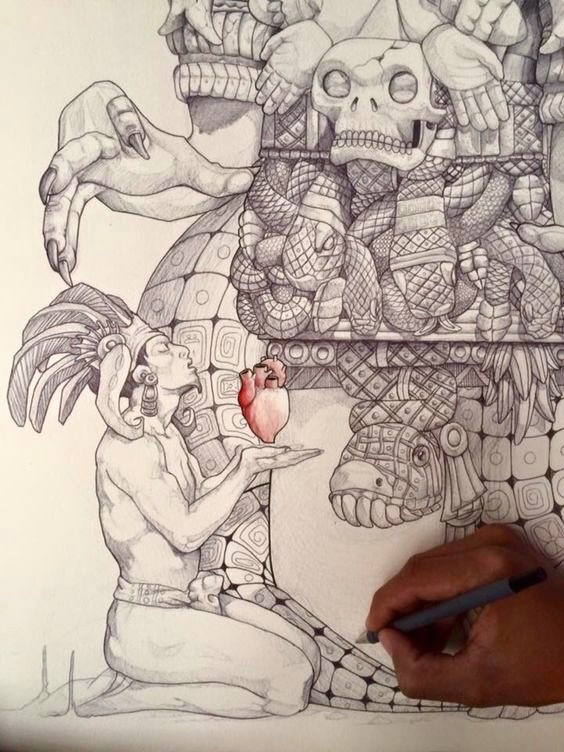
Bonus: Danza Coatlicue
The Aztec traditions have been kept alive for five hundred years by the Aztecs and their descendants, the modern day Nahua. Here are the concheros, an Aztec dance group, with a musical ritual celebrating Coatlicue:
Please subscribe to Temples ‘n’ Tribes. You will receive notices of current postings, about three new articles a month.
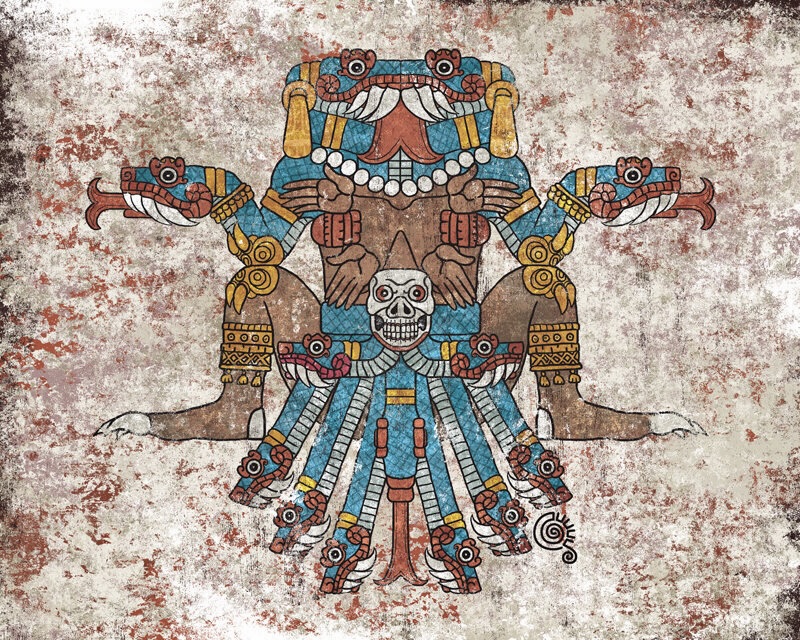
Very interesting!